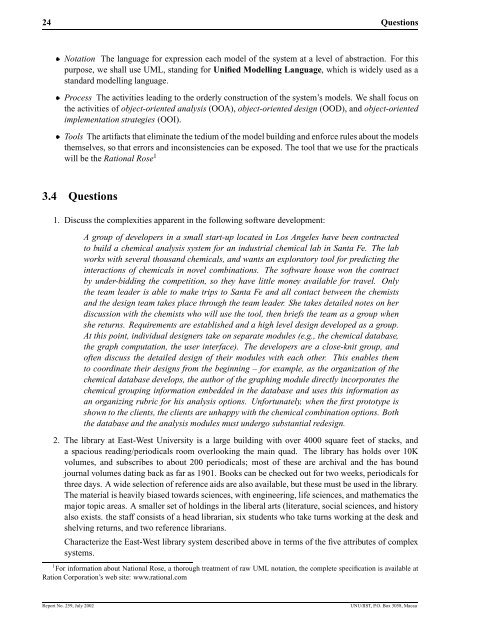Object-Oriented Software Development with UML - UNU-IIST ...
Object-Oriented Software Development with UML - UNU-IIST ...
Object-Oriented Software Development with UML - UNU-IIST ...
Create successful ePaper yourself
Turn your PDF publications into a flip-book with our unique Google optimized e-Paper software.
24 Questions¢Notation The language for expression each model of the system at a level of abstraction. For thispurpose, we shall use <strong>UML</strong>, standing for Unified Modelling Language, which is widely used as astandard modelling language.¢Process The activities leading to the orderly construction of the system’s models. We shall focus onthe activities of object-oriented analysis (OOA), object-oriented design (OOD), and object-orientedimplementation strategies (OOI).¢Tools The artifacts that eliminate the tedium of the model building and enforce rules about the modelsthemselves, so that errors and inconsistencies can be exposed. The tool that we use for the practicalswill be the Rational Rose 13.4 Questions1. Discuss the complexities apparent in the following software development:A group of developers in a small start-up located in Los Angeles have been contractedto build a chemical analysis system for an industrial chemical lab in Santa Fe. The labworks <strong>with</strong> several thousand chemicals, and wants an exploratory tool for predicting theinteractions of chemicals in novel combinations. The software house won the contractby under-bidding the competition, so they have little money available for travel. Onlythe team leader is able to make trips to Santa Fe and all contact between the chemistsand the design team takes place through the team leader. She takes detailed notes on herdiscussion <strong>with</strong> the chemists who will use the tool, then briefs the team as a group whenshe returns. Requirements are established and a high level design developed as a group.At this point, individual designers take on separate modules (e.g., the chemical database,the graph computation, the user interface). The developers are a close-knit group, andoften discuss the detailed design of their modules <strong>with</strong> each other. This enables themto coordinate their designs from the beginning – for example, as the organization of thechemical database develops, the author of the graphing module directly incorporates thechemical grouping information embedded in the database and uses this information asan organizing rubric for his analysis options. Unfortunately, when the first prototype isshown to the clients, the clients are unhappy <strong>with</strong> the chemical combination options. Boththe database and the analysis modules must undergo substantial redesign.2. The library at East-West University is a large building <strong>with</strong> over 4000 square feet of stacks, anda spacious reading/periodicals room overlooking the main quad. The library has holds over 10Kvolumes, and subscribes to about 200 periodicals; most of these are archival and the has boundjournal volumes dating back as far as 1901. Books can be checked out for two weeks, periodicals forthree days. A wide selection of reference aids are also available, but these must be used in the library.The material is heavily biased towards sciences, <strong>with</strong> engineering, life sciences, and mathematics themajor topic areas. A smaller set of holdings in the liberal arts (literature, social sciences, and historyalso exists. the staff consists of a head librarian, six students who take turns working at the desk andshelving returns, and two reference librarians.Characterize the East-West library system described above in terms of the five attributes of complexsystems.1 For information about National Rose, a thorough treatment of raw <strong>UML</strong> notation, the complete specification is available atRation Corporation’s web site: www.rational.comReport No. 259, July 2002<strong>UNU</strong>/<strong>IIST</strong>, P.O. Box 3058, Macau
















